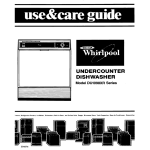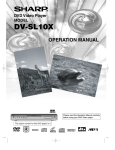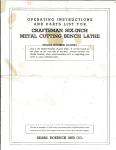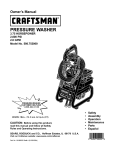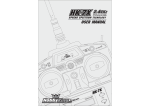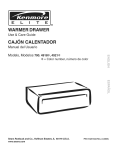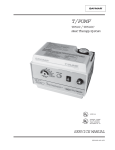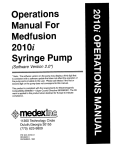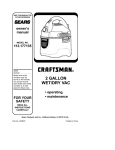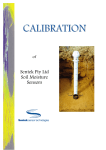Download Craftsman 315.11721 Owner`s manual
Transcript
OWNERS _NUAL MODEL NO. 315,11721 !i<i! ¸i i! ii CAUTION: Read Rules for CRRFTS!dRN° Safe Operation and Instructions Carefully DOUBLE SAVE THIS MANUAL FUTURE FOR REFERENCE INSULATED lntrodur.tion Operation Maintenance Repair Parts SEARSi ROEBUCK Designed exclusively for and sold onty by AND CO., Dept, 6gsi731A, Sears 'Tower, Chigago, IL 60684 FULL ONE YEAR WARRANTY ON CRAFTSMAN BELT SANDER If this Craftsman Belt Sander fails to give complete satisfaction within one year'from th_e of purchase RETURN IT TO THE NEAREST SEARS STORE THROUGHOUT THE UNITED STATES and Sears will repair it, free of charge, If this belt sander is used for commercial the date of purchase, This warranty state. gives you specific or rental purposes this legal rights, warranty applies for only 90 days from and you may also have other rights which vary from state to SEARS, ROEBUCK AND CO, DEPT. 698/731A SEARS TOWER CHICAGO, IL 60684 INTRODUCTION Your Craftsman 3-Inch Belt Sander is suitable for coarse, medium and fine sanding of wood, metals, plastics and other materials.-It is ideal when used for smoothing rough boards, chamfering, rounding edges and many other general sanding applications. It is ideal for refinishing large pieces of furniture, stairs and other large surfaces, its balanced design makes it easy to use. IMPORTANT -- Servicing of a tool with double insulation requires extreme care and knowledge of the system and should be performed only by a qualified service technician. For service, return the tool to your nearest Sears store for repair which will be done with original factory replacement parts. -SWITCH A trigger switch controls operation of the Sander. The trigger switch can be locked on for continuous operation. To lock, putt trigger, press lock button inward, and release trigger. Pull triggei" and release to stop. DANGER: Keep hands and fingers away from moving sanding belt. Any part of body coming in contact with moving belt could cause serious injury. DANGER: Do not wear loose clothing or jewelry when operating Sander. They could get caught in moving parts causing injury. Keep head away from Sander and sanding area. Hair could get caught in moving parts and foreign objects could get thrown away from Sander causing injury. Never use in an explosive atmosphere. Normal sparking of motor could ignite fumes. DOUBLE INSULATION Double insulation [s a concept in safety, in electric power tools, which eliminates the need for the usual three wire grounded power cord and grounded supply system. Wherever there is electric current in the tool there are two complete sets of insulation to protect the user. AI exposed metal parts are isolated from the internat metal motor components with protecting insulation. RULES FOR SAFE OPERATION WARNING -- DO NOT ATTEMPT TO OPERATE UNTIL YOU HAVE READ THOROUGHLY AND UNDERSTAND COMPLETELY ALL INSTRUCTIONS, RULES, ETC. CONTAINED IN THiS MANUAL. FAILURE TO COMPLY CAN RESULT IN ACCIDENTSoINVOLVING FIRE, ELECTRIC SHOCK, OR SERIOUS PERSONAL INJURY. SAVE OWNEJ_SMANUAI_-AND RE_IF.W_FREQpENTLY FOR CONTINUING SAFE OPERATION, AND INSTRUCTING iPOSSIBLE THIRD,PAR'_ USJEB._ ' " READ ALl, INSTRUCTIONS 1 KNQ_YOU_ POWER TOOL -- Read owner s manual carefully. Learn its ap_f_ti,c:;a_6r_s_'an'd;lir_'i_tations.as_well as the specific potential haz,_rds peculiar to thins tool, 2, _U_I_AGA_]Nj_T:_ISk_P.utRiCAL I/y_,,H G[ROUNDED'SURFACES, ei'_to r enclosures, SHOCK BY PREVENTING For example: 3. KEEP GUARDS IN PLACE and in working order. 4. KEEP WORK AREA CLEAN. Cluttered areas and benches 5, AVOID DANGEROUS locations or expose ENVIRONMENT. Don't BODY Pipes, radiators, use power CONTACT ranges, refrig- invite accidents. tool in damp or wet to rain. Keep work area well lit. 6. KEEP CHILDREN AWAY. All visitors area. Do not let visitors contact tool should be kept safe or extension cord. 7. STORE IDLE TOOLS, When not in use, tools locked-up place -- out of reach of children. Page 2 should " distance be stored from work in dry', high or RULES FOR SAFE OPERATION(Continued) 8. DON'T FORCE TOOL. It will do the job better and safer at the rate for which it was designed. 9. USE RIGHT TOOL. Don't force small too! or attachment to do the job of a heavy duty tool. Don't use tool for purpose not intended - for example - Don't use a circular saw for cutting tree limbs or logs. 10. WEAR PROPER APPAREL. No loose clothing or jewelry to get caught in moving parts. Rubber gloves and footwear are recommended when working outdoors. Also, wear protective hair covering to contain long hair. 11. USE SAFETY GLASSES with all tools. Also face or dust mask if cutting operation is dusty. 12. DON'T ABUSE CORD. Never carry toot by cord or yank it to disconnect from receptacle. Keep cord from heat, oit and sharp edges. !3. SECURE WORK. Use clamps or a vise to hold work. It's safer than using your hand and it frees both hands to operate tool. 14. DON'T OVERREACH. Keep proper footing and balance at all times. 15. MAINTAIN TOOLS WITH CARE. Keep tools sharp at all times, and clean for best and safest performance. Follow instructions for lubricating and changing accessories. 16. DISCONNECT TOOLS. When not in use, before servicing, or when changing attachments, blades, bits, cutters, etc. all tools should be disconnected. 17, REMOVE ADJUSTING KEYS AND WRENCHES, Form habit of checking to see that keys and adjusting wrenches are removed from tool before turning it on. 18. AVOID ACCIDENTAL STARTING. Don't carry plugged-in tools with finger on switch. Be sure switch is off when plugging in. 19. OUTDOOR USE EXTENSION CORDS. When tool is used outdoors, use only extension cords suitable for use outdoors. Outdoor approved cords are marked with the suffix W-A, for example m SJTW-A or SJOW-A. 20. 21. NEVER USE THIS OR ANY POWER SANDER FOR WET SANDING. Failure comply can result in electrical shock causing serious injury or worse. KEEP HANDS AWAY FROM SANDING AREA. to 22. NEVER USE IN AN EXPLOSIVE ATMOSPHERE. Normal sparking of the motor could ignite fumes, 23. INSPECT TOOL CORDS PERIODICALLY and if damaged, have repaired at your nearest Sears Repair Center. 24. INSPECT EXTENSION CORDS PERIODICALLY and replace if damaged. 25. KEEP HANDLES DRY, CLEAN, AND FREE FROM OIL AND GREASE. Always use a clean cloth when cleaning. Never use brake fluid, gasoline, or any strong solvents to clean your tool. 26. STAY ALERT. Watch what you are doing and use common sense. Do not operate tool when you are tired. 27. CHECK DAMAGED PARTS. Before further use of the tool, a guard or other part that is damaged should be carefully checked to determine that it will operate properly and perform its intended function. Check for alignment of moving parts, binding of moving parts, breakage of parts, mounting, and any other conditions that may affect its operation. A guard or other part that is damaged should be properly repaired or replaced by an authorized service center unless indicated elsewhere in this instruction manual. 28. DO NOT USE TOOL IF SWITCH DOES NOT TURN IT ON AND OFF. Have defective switches replaced by authorized service center. 29, 30. Inspect for and remove all nails from lumber before DRUGS, ALCOHOL, MEDICATION. Do not operate uence of drugs, alcohol, or any medication. 31. SAVE THESE INSTRUCTIONS. Page 3 sanding. tool while under the infl- OPERATION Fig. I'" Fig, 2 TRACKING Fig, 3 PREPARING FOR OPERATION For ease of operation your Sander has a front handle and a rear handle. These handles allow two-hand operation which aids in maintaining control and keeping sanding area level with workpiece. When operating your Sander hold the front handle with your left hand and the rear handle with your right hand as shown in Fig. 1. Selecting the correct size and type sanding belt is an extremely important step in achieving a high quality sanded finish. Aluminum oxide, silicone carbide, and other synthetic abrasives are best for power sanding. In general, coarse grit wilt remove the most material and finer grit will produce best finish in all sanding operations. The condition of the surface to be sanded witt determine which grit belt will do the job. If the surface is rough, start with a coarse grit belt sanding until surface is uniform. Medium grit belt may then be used to remove scratches teft by the coarser belt and finer grit belt used for finishing of the surface. Always continue sanding with each grit belt until surface is uniform. INSTALLING AND ADJUSTING SANDING BELT Disconnect sander from power supply. See Figure 2. Release tension on belt by ;_ushing the front pulley squarely against the top or edge of workbench. When the pulley is pushed back it will lock in that position allowing slack in the belt so it can be removed. Install new belt making sure arrow on inside of belt is pointing in the direction of rotation which is clockwise when looking into open side of sander. To put tension on the belt, insert a screwdriver between the idler pulley support bracket and the idler pulley support as illustrated and pry toward front of sander. To adjust sanding belt, connect sander to power supply. Place sander in an upside down position as illustrated (See Fig. 3), pull switch trigger and release immediately while observing tracking of sanding belt. If sanding belt runs outward turn tracking screw clockwise and counterclockwise if belt runs inward. This should be done until you are sure belt will not come in contact with striker bar. When you are sure belt wilt not rub against striker bar start sander and fine adjust the tracking screw until belt stabilizes. When correctly adjusted, the outer edge of the belt will be even with the outer edge of sanding shoe pad (Key 28, page 11). Belt life will be increased appreciably if a few seconds are spent adjusting the belt tracking. NOTE: Idler pulley rubbing housing when in the released position without sandpaper is not harmful to the operation of the tool. The sanding belt, when assembled, wit not allow pulley to project as far. TO OPERATE Clamp or otherwise secure the work to prevent it moving under the Sander. DANGER: Unsecured work could be thrown back toward operator causing injury. With Sander off work, press the trigger switch and when the motor reaches its maximum speed, lower the Sander on the work with a slight forward motion. Using the rear handle to control the Sander and the front handle only to guide it, move it slowly over the work. Allowing the Sander to remain in one place will result in an uneven surface. The Sander was designed to provide the proper weight on the sand belt and extra pressure will only result in uneven work, slow cutting from slow belt speed, clogged belts and possible motor bum-out. Use the proper belt when heavy cutting is desired, not heavy pressure. The importance of this cannot be over-emphasized, the weight has been built into the tool to give the most efficient pressure at the proper location. Page 4 MAINTENANCE WHEN SERVICING USE ONLY IDENTICAL BRUSH REPLACEMENT PARTS. REPLACEMENT Disconnect Sander from power supply before servic. ing. 1, Remove brush caps (A) with screwdriver, 4. , Remove fibre Washers (B). The washers are designed to fit tightly in the brush holders to prevent twisting of brush springs when replacing brush caps, 3, Remove brushes BRUSH --! Fig. 4. See Fig. (C), 4: Reassemble brush with spring into tool making sure that the curvature of the brush matches curvature of the motor and thatthe brush moves freely in the brush holder. 5. Replace fibre washers and brush caps. LUBRICATION All bearings in this tool are lubricated with a sufficient amount of high grade lubricant for the life of the unit under normal operating conditions. therefore, no further lubrication is required. TIMING BELT REPLACEMENT (See Figure 5) Disconnect sander from power supply before servicing. 1. Remove two screws, Key No. 53 (See parts list, page eleven) and then remove belt cover Key No. 43, 2. Force old belt off small pulley with a screwdriver and remove it from large pulley: 3. Install new belt over large pulley first, making sure teeth on belt mesh with teeth on pulley. 4. Press the belt onto the small Fig. 5 5. Reassemble Page 5 pulley. belt cover and screws; GENERAL Only the parts shown on parts list, page eleven, are Intended to be repaired or replaced by the customer. All other parts represent an important part of the double insulation system and should be serviced only by a qualified service technician. Avoid using solvents when cleaning plastic parts. Most piasttcs are susceptible to various types of commercial solvents and may be damaged by their use. Use clean cloths to remove dirt, carbon dust, etc. WARNING: DO NOT AT ANY TIME LET BRAKE FLUIDS, GASOLINE, PENETRATING OILS, ETC. COME IN CONTACT WITH PLASTIC PARTS. THEY CONTAIN CHEMICALS THAT CAN DAMAGE AND/OR DESTROY PLASTIC. EXTENSION CORDS The use of any extension cord wilt cause some loss of power. To keep the loss to a minimum and to prevent tool overheating, follow the recommended cord sizes on the chart at right. When tool is used outdoors, use only extension cords suitable for outdoor use and so marked. Extension cords are available at Sears Catalog Order or Retail Stores. CAUTION When electric tools are used on fiberglass boats, sports cars, etc., it has been found that they are subject to accelerated wear and'_ble premature failure, as the fiberglass chips a_n_rfndings are highly abrasive to bearings, brushes, commutator, etc. Consequently, it is not recommended that this tool be used for extended work on any fiberglass material. During any use on fiberglass it is extremely _mportant that the tool is cleaned frequently by blowing with an air jet. ALWAYS WEAR SAFETY GLASSES OR EYE SHIELDS BEFORE BEGINNING POWER TOOL OPERATION. Extension Cord Length 25-50 Feet 50-100 Feet Wire Size A.W.G. 16 14 WARNING: CHECK EXTENSION CORDS BEFORE EACH USE. IF DAMAGED, REPLACE IMMEDIATELY. NEVER USE TOOL WITH A DAMAG ED EXTENSION CORD, SINCE TOUCHING THE DAMAGED AREA COULD CAUSE ELECTRICAL SHOCK RESULTING IN SERIOUS INJURY. The operation of any sander can result in foreign ob. jects being thrown into the eyes, which can result in Severe eye damage. Always wear safety glasses or eye shields before commencing power tool opera, ti0n. We recommend Wide Vision Safety Mask for use over spectacles, or standard safety glasses... available at Sears Catalog Order or Retail Stores. THE FOLLOWING RECOMMENDED ACCESSORIES ARE CURRENT AND WERE AVAILABLE AT THE TIME THIS MANUAL WAS PRINTED, CORD LOCK Cot, No, 9 2595 ASSORTED SANDING BELTS Cat. No. 9 22304--X.Fine Cat. No; 9 22301--Fine Cat, No. _922302--Medium Cat. No. _922303--Coarse Cat. No._9 22305--X-Coarse CARRYING CASE Cat, No. 9 1475 DUSTLESS SANDING ATTACHMENT Car, No, 9 11765 CAUTION: The use of attachments or ecceuortet Page 6 not listed a_e n_lht be kazerdou=. NOTES Page 7 NOTES Page 8 NOTES Page 9 'i'm ,tin qp" X ::) Z .J t.U 0 :E ul 0 i iu L :€ ILl Q Z €,n ILl n,t = U _z E < < L n, 0 u_ ::::::::::_:::::_ _= I-, r./) ........ i=_........ . . _ .... 13- .... 0 (_ • (.3 • ,_ • .=_ EO • €: IIi o_ _, _o _8 '"o _' _ )_ - ,,_ tlg g_ L_. - £_ al_o _ oE o w QQ_ Z_-- P 0 _ I- o.__c: ii!: ... --'_ o :::::::::: ::::::_'.', ,l I11 o u F, _l.;j _z H m '" 0 ,z'_ _ o o I: _o K m I E I E_ N 0 00 _0_0 _ 9999. m9 99 _ 0000 _9_9_N E • m = € ooo_m° £ CRRFTSMRN 3 INCH BELT SANDER OWNERS MANUAL DOUBLE INSULATED SERVICE Now that you have purchased your Belt Sander, should a need ever exist for repair parts or service, simple contact any Sears Service Center and most Sears, Roebuck and Co. stores. Be sure to provide all pertinent facts when you cal! or visit. MODEL NO. The model number of your Belt Sander will be found on the plate attached to the idler pulley support bracket, 315,1172I WHEN ORDERING REPAIR PARTS, T H E FOLLOWt NG 1N FORMAT IO N: HOW TO ORDER REPAIR PARTS • PART " MODEL NUMBER NUMBER 315.11721 ALWAYS • PART DESCRIPTION • NAME OF ITEM 3" Belt Sander All parts listed may be ordered from Center and most Sears stores. any Seers Service tiJrj,I II!, lr IIifliiitlifii If the parts you need are not stocked locally, your order will be electronically transmitted to a Sears Repair Parts Distribution Center for handling, 612547 -072 OWNR8 MANU GIVE I ! SEARS, ROEBUCK AND CO., Dept. 698/731A, Sears Tower, Chicago, IL 60684












